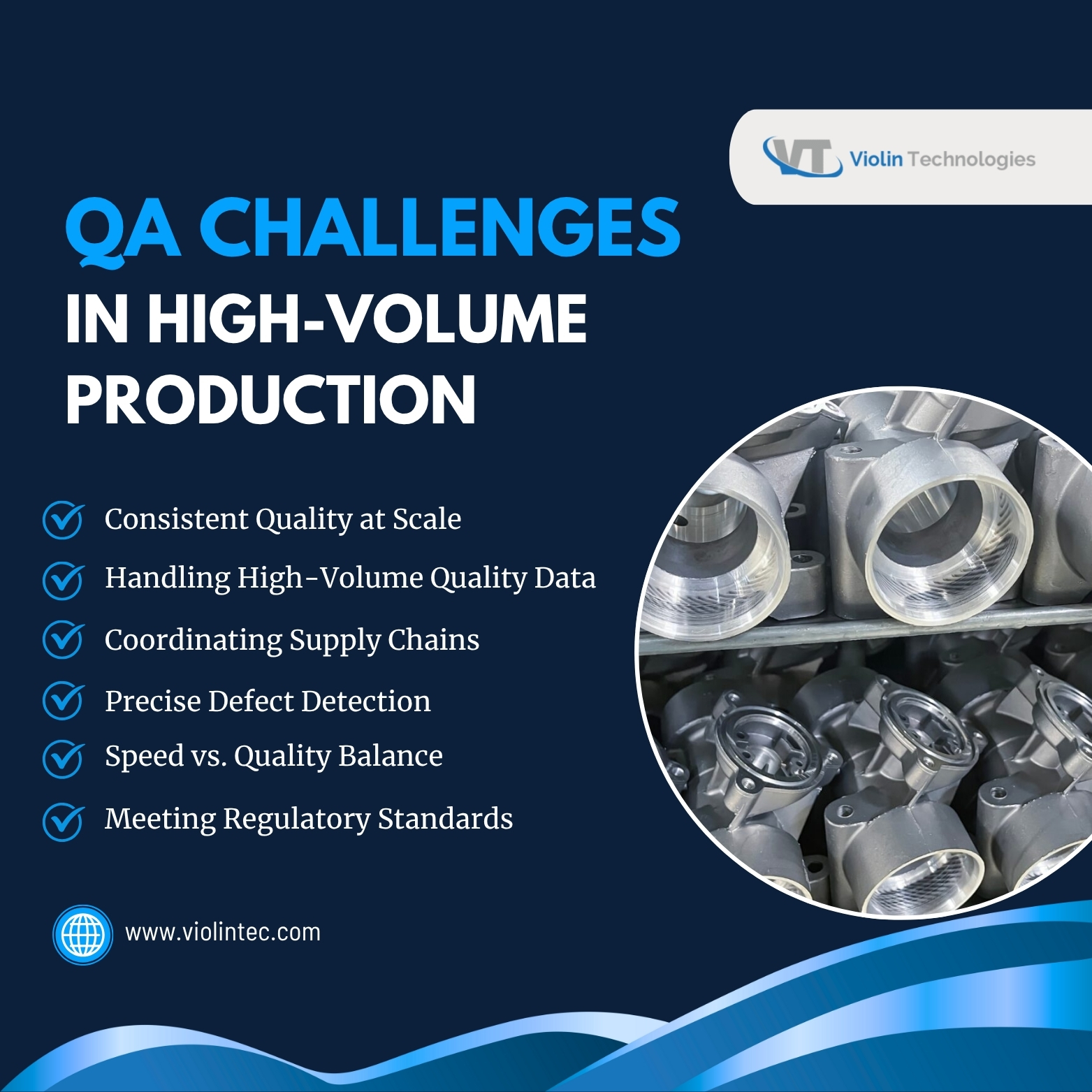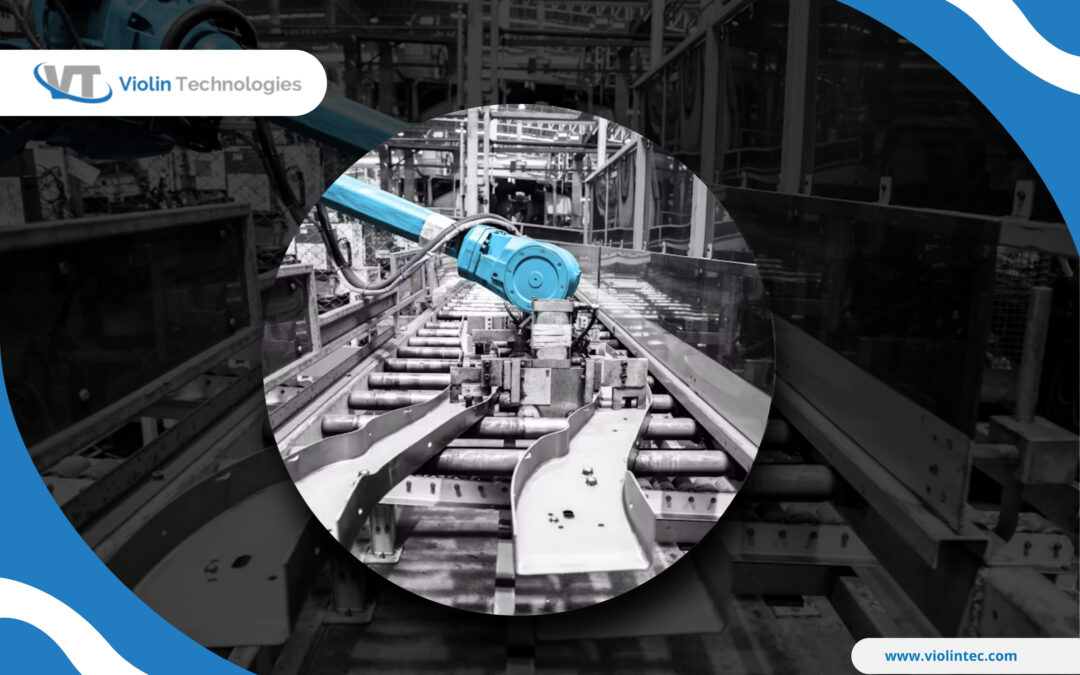How can manufacturers overcome these formidable QA challenges while maintaining fast and cost-effective operations? This article examines the most persistent QA challenges in high-volume manufacturing and provides actionable strategies to overcome them, drawing on practical insights from industry best practices.
What we cover in this blog?
QA Challenges in High-Volume Production
Highly automated procedures, complex supply chains, and the unwavering need to strike a balance between speed and unwavering quality are characteristics of high-volume production. Even minor QA lapses on this scale can lead to systemic issues, making robust quality control unavoidable. Here’s a breakdown of the most important challenges and their solutions.
1. Consistent Quality at Scale
Challenge: Ensuring that each unit meets the same high standard is one of the most challenging tasks in large-volume manufacturing. Maintaining uniformity can be difficult when hundreds of products come off the assembly line.
Solution: Standardized quality control processes must be implemented to maintain progress. One excellent tool for real-time monitoring of production processes is statistical process control, or SPC. This makes it easier to identify any deviations early on before they become more serious. Maintaining consistency across your production runs also requires rigorous attention to quality protocols and routine calibration of equipment.
The best contract manufacturers in India offer comprehensive solutions, encompassing design support, manufacturing, assembly, and testing.
2. Handling Large Volume of Quality Data
Challenge: Manufacturing at high volumes generates vast quantities of production and quality data. One of the biggest challenges is interpreting this data in real-time and turning it into actionable insights.
Solutions: Leverage advanced data analytics to gather quality indicators across all phases and platforms. Analytics technologies make it easier to identify trends, track defect rates, and uncover underlying causes that might otherwise go unnoticed.
Additionally, create dashboards that display KPIs such as yield, cycle times, and defect counts in real-time. Include alarm systems for threshold violations to enable remedial measures to be implemented before problems worsen.
3. Coordinating with Supply Chains
Challenge: High-volume manufacturing often requires coordination with multiple vendors. However, ensuring that every part and material meets your quality requirements can be a major challenge.
Solution: Develop a solid rapport with your suppliers and include explicit quality requirements in your contracts to expedite this process. To ensure that everyone is in agreement, regular supplier audits and performance evaluations are crucial. Another way to maintain transparency and structure is to utilize a centralized supplier management system.
4. Precise defect detection
Challenge: Early defect detection is crucial to prevent more severe issues later in a high-volume setting. If ignored, small problems can quickly escalate into significant concerns.
Solution: Invest in automated inspection technologies and real-time monitoring to monitor quality as it occurs. This proactive strategy enables you to identify flaws early and take swift action to fix them. Furthermore, address the underlying causes of problems and prevent them from happening again by establishing a strong feedback loop.
5. Speed Vs Quality Balance
Challenge: Sometimes, the pressure to increase production speed results in quality sacrifices. Maintaining standards without slowing down your production process requires finding the ideal balance between speed and quality.
Solution: Create a production schedule that balances quality standards with speed. It’s also critical to train your workforce to perform effectively while maintaining quality standards. Process optimization, waste reduction, and maintaining speed and quality control can all be achieved by implementing lean manufacturing principles.

6. Meeting regulatory standards
Challenge: High-volume manufacturing requires adherence to industry standards and laws but handling this can be challenging.
Solution: Stay informed on the most recent rules and guidelines. Ensure that all of your procedures are set up to meet these specifications. You can maintain compliance by routinely evaluating and revising your quality assurance protocols. To make sure that everyone agrees, it is also crucial to train your employees to these standards.
7. Quality Assurance Scaling
Challenge: Scaling your QA procedures can be difficult as your production volumes rise. It’s crucial to make sure your quality assurance processes can adapt to expansion.
Solution: Take scalability into consideration when designing your QA procedures. Purchasing scalable systems and technologies will enable you to manage higher production volumes without sacrificing quality. Your QA procedures will continue to function well as your production will grow if you regularly evaluate and modify them.
Conclusion
To overcome QA issues in high-volume manufacturing, a strategic combination of proactive supplier management, standardized procedures, real-time data analytics, strong automation, and continuous employee training is needed. In an increasingly competing global market, businesses that make these investments position themselves to enhance customer satisfaction, deliver quality at scale, and protect their reputation.
FAQs
1. How do manufacturers ensure consistent quality in large batches?
Utilize statistical process control, standard operating procedures, and automated inspection systems to identify defects early.
2. In high-volume production, what is the best method to identify defects?
Use machine vision systems and real-time monitoring technology for quick problem detection.
3. How can businesses maintain quality while handling the complex nature of supply chains?
To avoid inconsistent input quality, centralize supplier management, establish explicit quality contracts, and conduct routine supplier audits.
4. What techniques aid in striking a balance between quality and speed in high-volume manufacturing?
Adopt lean manufacturing techniques, train employees regularly, and develop a culture that prioritizes efficiency and quality enhancement.

